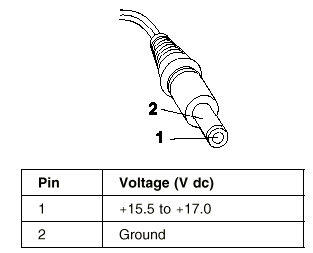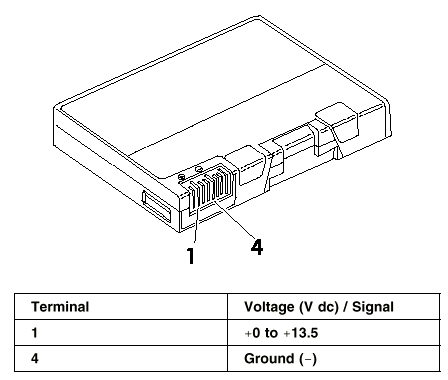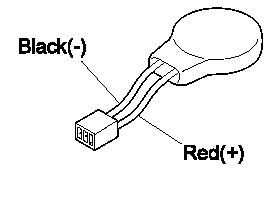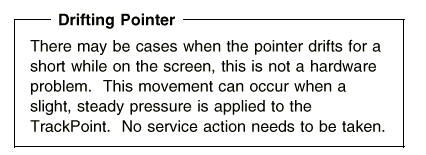

|
79.480 bytes |
Service Hints & Tips |
Document ID: BMOE-42KMDH |
TP 380Z - General Checkout Guide
Applicable to: World-Wide
The following information is intended for IBM Dealers and Authorized Servicers only. Customers attempting to follow any of the procedures below may void their warranty.
Checkout Guide
Use the following procedure as a guide for computer problems.
Note: The diagnostic tests are intended to test only IBM products. Non-IBM products, prototype cards, or modified options can give false errors and invalid system responses.
1. Obtain the symptoms in detail.
2. Verify the symptoms by running the diagnostic test to re-create the same error or by repeating the same operation.
Note:
To run the diagnostic test, refer to "Running the Diagnostics"
If the symptoms occur at irregular intervals and cannot be re-created (and therefore cannot be verified), go to "Symptom-to-FRU Index" ; then go to ô"Intermittent Problems".
3. Match the verified symptoms with the following table and determine the page to go to.
|
Verified Symptoms |
Go To |
|
Power failure. (The power indicator does not go on or stay on.) |
"Power Systems Checkout" |
|
POST does not complete. No beeps or error codes are displayed. |
"Symptom-to-FRU Index" , and then go to "No Beep Symptoms". |
|
The configuration is not the same as the installed devices. |
"Checking the Installed Devices List" |
|
POST beeps, but no error codes are displayed. |
"Symptom-to-FRU Index", and then go to "Beep Symptoms" |
|
POST detected an error and displayed numeric error codes. |
"Symptom-to-FRU Index", and then go to "Numeric Error Codes". |
|
The diagnostic test detected an error and displayed a FRU code. |
"FRU Codes". |
|
Other symptoms (such as LCD monitor problems). |
"Symptom-to-FRU Index", and then go to "Other Symptoms". |
2. Select Audio and run the diagnostic tests.
3. If the test detects an audio problem, replace the system board.
Diskette Drive Checkout
This checkout is to isolate the problem to a controller, drive, or diskette. A write-enabled, blank, formatted 2HD diskette is required.
FDD-1 represents a diskette drive in the ThinkPad computer.
Attention
Make sure that the diskette does not have more than one label pasted on its surface. Inserting diskettes with multi-layered labels into the drive can damage it.
Take the following procedure to select the test device:
1. Click on Test in the Easy-Setup menu.
2. Press Ctrl+A to enter the advanced diagnostic menu.
The ThinkPad FRU Connections window appears.
3. Click on Exit The keyboard layout appears on the screen.
4. Click on Exit.
5. Click on FDD-1.
6. Type Y (Yes) to the question that appears on the screen. Insert a blank diskette into the drive when instructed.
7. Press Enter to run the diskette drive test.
a. If the controller test detects an error and FRU code 10 appears, replace the system board.
b. If the controller test runs without any errors, the drive read/write tests start automatically.
c. If the drive read/write test detects an error and either FRU code 50 for FDD-1 appears, replace the drive.
If the drive is attached to a port replicator, go to "Port Replicator Checkout" to isolate the replicator. Otherwise, go on to the next step.
8. If the drive is attached through a port replicator, go to the service manual of the port replicator to isolate the problem.
9. If no error occurs when you test the formatted diskette, suspect the diskette that the customer used when reporting the problem.
Fan Checkout
To check the fan, listen for the fan. If you cannot hear it running at power-on, replace the fan. If you can hear it running but not steadily, run the diagnostic test as follows:
1. Start Easy-Setup.
2. Click on Test.
3. Press Ctrl+A to enter the advanced diagnostic mode.
The ThinkPad Connection windows appear.
4. Click on Exit. The keyboard layout appears on the screen.
5. Click on Exit again.
6. Click on System Board then press Enter to run the test.
Follow the instructions that appear on the screen. If the test detects a fan problem, replace it.
Keyboard or Auxiliary Input Device Checkout
Remove any external keyboard before testing the built-in keyboard.
If the keyboard does not work or an unexpected character appears, make sure that the flexible cable extending from the keyboard is correctly seated in the connector on the DC/DC card.
If the keyboard cable connection is correct, check the DC/DC card.
If the tests do not detect a keyboard problem, run the keyboard test by doing the following:
1. Go to the diagnostic menu by selecting Test in the Easy-Setup menu.
2. Press Ctrl+A to enter to the advanced diagnostic mode.
The ThinkPad FRU Connections window appears. (If Ctrl+A does not work, triple-click on the icon on the right bottom corner of the basic diagnostic window.)
3. Make sure that the keyboard connection is Connected; then press Esc to exit the screen.
A layout of the keyboard appears on the screen.
4. Check that when each key is pressed, the key's position on the keyboard layout on the screen changes to a black square.
Note: When the Fn key is pressed, a black square appears briefly.
5. Press Ctrl+Pause to end the test.
If the tests detect a keyboard problem, do the following one at a time:
Warning: Do not replace a nondefective FRU.
Reseat the keyboard cables.
Replace the DC/DC card.
Replace the system board.
Auxiliary Input Devices:
The following auxiliary input devices are supported:
Numeric keypad
Mouse (PS/2 compatible)
External keyboard (with keyboard/mouse cable)
If any of these devices do not work, reseat the cable connector and repeat the failing operation.
If the problem remains, replace the device, and then the system board.
Memory Checkout
DIMMs are available for increasing memory capacity.
|
DIMM |
Displayed Value |
|
No DIMM installed |
32192 KB |
|
16 MB |
48576 KB |
|
32 MB |
64960 KB |
|
64 MB |
97728 KB |
Memory errors may cause error messages to appear on the screen or may hang the operating system.
Take the following procedure to isolate memory problems:
1. Turn off the computer and remove any installed DIMM from the slot.
2. Press and hold the F1 key; then turn on the computer. Hold the F1 key down until the Easy-Setup menu appears.
3. Select Test and press Enter.
4. Select Memory and press Enter to run the memory test for the base memory. If an error appears, replace the system board.
5. Turn off the computer and reinstall the DIMM; then turn on the computer. Verify the memory size; then test the memory. If an error message appears,
replace the DIMM.
If a memory problem occur intermittently, perform the loop option test. If the test detects an error, it prints an error log on a printer connected to the parallel port. See "Displaying the Error Log" for more information.
Power Systems Checkout
To determine whether a power systems problem is due to the AC Adapter or the battery, do the following:
1. Remove the battery.
2. Connect the AC Adapter and check that power is supplied.
3. Disconnect the AC Adapter and install the charged battery; then check that power is supplied by the battery.
If the problem is due to the AC Adapter, go to "AC Adapter Checkout"
If the problem is due to the battery, go to "Battery Checkout"
If the problem is not due to the AC Adapter or the battery, go to "Backup Battery Checkout (Nonrechargeable)"
AC Adapter Checkout:
This checkout is used only when the computer fails under ac power.
If the problem occurs only when the AC Adapter is used with a port replicator, replace the replicator.
If the power-on indicator does not turn on, check the power cord of the AC Adapter for conductivity and installation.
1. Unplug the AC Adapter cable from the computer and measure the output voltage at the cable plug. See the following figure:

a. If the voltage persists, go to the next step.
b. If the voltage is correct, make sure the connection between the DC/DC card and the system board is not loose.
c. Replace the DC/DC card.
d. If the problem is not corrected, replace the system board.
e. If the problem persists, go to "Undetermined Problems".
2. Unplug the AC Adapter cable from the ac power outlet and wait 5 minutes or longer to allow the overvoltage protection circuit to be fully discharged
and initialized.
3. Plug the AC Adapter cable into the ac power outlet.
4. Measure the output voltage of the AC Adapter.
5. If the voltage is still not correct, replace the AC Adapter.
Note: An audible noise from the AC Adapter does not always indicate a defect.
Battery Checkout:
If the error is due to the battery, do the following:
1. Turn off the computer.
2. Remove the battery and measure the voltage between the battery terminals 1 (+) and 4 (N).

Note: Signal lines not used in these steps are used for communication between the system and the battery.
3. If the voltage is less than +11.0 V dc, the battery has been discharged. Recharge the battery.
If the voltage is still less than +11.0 V dc after recharging, replace the battery.
Note: The voltage of the battery could show 0 V because of the overdischarge protectioncircuit. Try to trickle charge the battery by attaching it to the computer with the AC adapter.
4. If the voltage is more than +11.0 V dc, measure the resistance between the battery terminals 3 and 4. The resistance must be 4 to 30 K ohms.
If the resistance is not correct, replace the battery .
If the resistance is correct, replace the DC/DC card.
Checking Operational Charging
Note: Battery charging will not start unless the Fuel-Gauge is below 95%. At below 95%, the battery will start charging to 100% of its capacity. This limitation protects the battery from overcharging and also prolongs its life.
To check the operational charging, install a fully discharged battery or a battery that is less than 50% charged.
Turn on the computer while it is connected to the AC Adapter. If the battery status indicator does not turn on, turn off the computer, remove the battery, and let the battery return to room temperature. Reinstall the battery, and turn on the computer (still connected to the AC Adapter). If the charge indicator still does not turn on, replace the battery.
Backup Battery Checkout (Nonrechargeable)
1. Turn off the computer and unplug the AC Adapter from the computer.
2. Open the Mmoery-slot cover.
3. Remove the backup battery. (Refer to "1010 DIMM Card and Backup Battery" to remove the battery.)
4. Measure the voltage of the backup battery connector.


If the voltage is correct, replace the system board.
If the voltage is not correct, the backup battery has been discharged. Replace the backup battery.
If the backup battery discharges quickly after replacement, replace the system board.
Status Indicator Checkout
If an LED problem occurs, do the following:
1. Turn off the computer.
2. Turn on the computer.
3. All the LEDs in the indicator panel should turn on for a moment soon after the computer is powered on. Make sure they turn on.
If the problem persists, replace the system board.
System Board and CPU Card Checkout
The system board and the CPU card FRUs perform the operation on the computer. Processor problems can be caused by either FRU. Generally, the CPU card has a lower failure rate. If a numeric code indicates the system board or the CPU card as failing, do the following procedure to isolate the problem:
1. Run the system board test to verify the symptom. This test verifies both the system board and the CPU card. If no error is detected, return to "Undetermined Problems".
Note: Do not touch the keyboard and the pointing device when the system board is being tested. This might cause unexpected errors.
2. If FRU code 10 appears, replace the system board, but do not replace the CPU card. Transfer the CPU card from the old system board to the new system board.
3. If FRU code 11 appears, reseat the CPU card.
4. Rerun the test to verify the fix.
5. If FRU code 11 remains, replace the CPU card.
If this procedure does not correct the problem, go to "Undetermined Problems".
TrackPoint Checkout
If the TrackPoint does not work, do the following:
1. Run the ThinkPad Configration program and check if the TrackPoint is enabled.
2. If it is not, select Enable and enable it.
3. If you still have a problem, continue to the next step.

4. Go to the Easy-Setup menu.
5. Move to an item with the TrackPoint.
6. Press either the left or the right click button.
7. Verify that both buttons work correctly.
8. Move to another item with the TrackPoint.
9. Press the TrackPoint (Press-to-Select).
10. Verify that the item is selected.
11. If the problem still persists, do the following one at a time:
Warning: Do not replace a nondefective FRU.
Reseat the TrackPoint cable.
Replace the keyboard.
Replace the DC/DC card.
Replace the system board.
Optional Device Checkout
If you suspect an optional device problem, do either of the following:
"Port Replicator Checkout"
"External Monitor Self-Test"
Port Replicator Checkout
Do the following procedures to isolate a port replicator problem. A port replicator attaches to the system expansion connector on the bottom of the computer.
1. Turn off the computer.
2. Remove the failing devices from the replicator.
3. Unplug the AC adapter from the replicator, if attached.
4. Remove the port replicator from the computer.
5. Reconnect the failing device directly to the computer. (If another device is already connected to the computer, remove it first.)
6. Go to the "Running the Diagnostics" and run the diagnostics.
7. If the advanced diagnostic device test does not find an error, suspect a problem with the port replicator of the system expansion bus.
8. Turn off the computer and reconnect the port replicator.
9. Turn on the computer and run the following advanced diagnostic tests:
Serial port test with the wrap plug installed on the replicator
Parallel port test with the wrap plug installed on the replicator
10. If diagnostic errors appear, replace the replicator or diskette drive attachment unit. If the problem remains after the replacement, replace the system board.
11. If power problems appear only when the replicator is used, replace the replicator.
External Monitor Self-Test
If a monitor problem occurs only when an external monitor is connected, do the following:
Note: Before you replace a monitor:
Check that the 95XX systems support either 63XX, 85XX, or 95XX displays.
Make sure that the external monitor is properly connected to the computer.
If the screen is rolling, replace the external monitor. If that does not correct the problem, replace the FRUs in the following order:
1. System board
2. Bus adapter (if used)
If the screen is not rolling, run the monitor self-test as follows:
1. Power-off the computer and monitor.
2. Disconnect the monitor signal cable.
3. Power-on the monitor
4. Set the contrast to its maximum position.
5. Set the brightness control to the center detent position.
Check the following conditions:
The screen contrast and brightness control are adjustable.
The screen is either white or light gray, with a black margin (test margin).
The screen is set to CRT or both on the ThinkPad Configration program.
Note: The location of the test margin may vary with the type of monitor. It can be either at the top and/or bottom, or left and/or right of the screen.
If you do not see a test margin on the screen, replace the monitor. If there is a test margin on the screen, replace the system board.
|
Search Keywords |
| |
|
Hint Category |
Hardware Maintenance Information | |
|
Date Created |
25-11-98 | |
|
Last Updated |
19-01-99 | |
|
Revision Date |
19-01-2000 | |
|
Brand |
IBM ThinkPad | |
|
Product Family |
ThinkPad 380Z | |
|
Machine Type |
2635, 2636 | |
|
Model |
Various | |
|
TypeModel |
| |
|
Retain Tip (if applicable) |
| |
|
Reverse Doclinks |